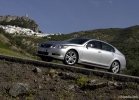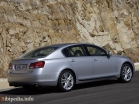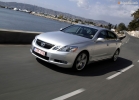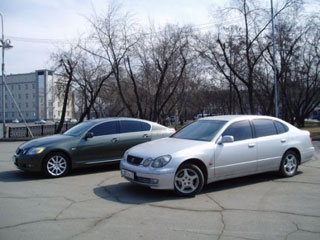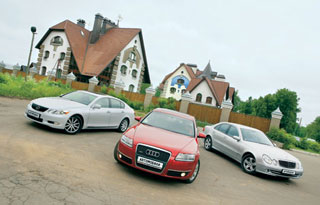Test drive Lexus GS 2005 - 2008 sedan
Japanese Janus
The classic of the rear -wheel drive of a luxurious sedan and high technologies of advanced electronics. V-shaped engines of large volume and 6000 min-1 on a tachometer. European traditions and Asian roots. All this was connected in one car. Allow me to imagine: GS Lexus GS. New!Janus - in Roman mythology, the deity of the doors, entrance and exit, then - every beginning. It was portrayed with two persons (one is turned into the past, the other into the future) ...
Russian encyclopedic dictionary
It is difficult to evaluate the external design of the car at the close parking of the airport, and therefore, plunging the equipment into a bottomless trunk, hurrying behind the wheel of a car with a three -liter V6. The key to the new generation Lexus GS, finally, is fully in harmony with the status of the brand: it is pleasant to pick it up and feel the appropriate severity. Stylish thing. Naturally, you don’t need to insert anything anywhere. The presence of this accessory aboard is enough. The machine comes to life with the pressing of the Start button: the steering column occupies the operating position, and the dashboard is displayed by optital lights. The technogenic white glow of the shooters and numbers against the background of the milling metal of the devices is noticeably, even when the bright sun is on the street: it is just beautiful.
The usual alertness, which is present at the first acquaintance with each new car, disappeared after a couple of hundred meters after leaving the parking lot. The whole machine is saturated with a sense of threate and predictability of its behavior on the go. The steering wheel is filled with the real life of the road, there are practically no reaction delay to its deviations. The brakes are controlled precisely: no clicks or other surprises. Automatic transmission regularly does its job, always performing adequate switching quickly and softly.
We can say that the suspension is slightly harsh for a car of this class.
In general, there are few significant complaints. The noise of the incoming stream becomes tangible after 120 kilometers per hour. The acoustic atmosphere on board as a whole is a little strange. The music here sounds very mediocre, and talking to a fellow traveler, even with the radio turned off, has to loudly. Subsequently, it became clear that the reason for these paradoxes in the use of the latest sound -absorbing materials in the manufacture of upholstery of the cabin. However, the fact that the Summer accepts is not always good for the ear.
The road, meanwhile, is becoming more and more winding. More and more interesting and less high -quality. It allows you to evaluate the impressive passages of suspension on unloading, the verified balance of the machine in a stable turn and the reliability of the action of stabilization systems. Their configuration is safe, but also flatters the trust of a person: Traction Control and ABS join the work as late as possible. At the same time - timely, allowing the driver to be himself and not interfering in the process before you made a mistake.
In fact, digging in the nuances and dividing the Lexus GS 300 movement process is quite difficult: all aspects of the running properties are soldered to a monolith that does not see the seams. Scientific demagogy is simply drowning in the pleasure of driving a machine, in which (it happens) everything is correct, logical, predictable and efficiently. Alas, that’s the end of the journey.
The exchange of first impressions with colleagues defeated the Russian delegation into two camps: Veselchaks smiling at the sun, sky, car, and thinkers. The latter in conclusions are extremely careful and immersed in difficult thoughts. However, after all, the cars were two stripes: moderate, with a three-liter V6 and a top version with a V8 engine of 4.3 liters.
The differences between the two options are huge. The top version of the Lexus GS 430, one might say, personifies the top of technological delights available to today's buyer in a serial car.
VGRS (Variable Gear Ratio Steering) is a steering control with a variable transfer of a transfer. The dependence of the sensitivity of the steering wheel on speed, I think, does not require explanation. However, this is far from all that the steering mechanism can. Analyzing the speed of the car, clutch the road with each of the wheels and the angular speed of the machine around the vertical axis, electronics can make adjustments to the steering process. Thus, the proprietary stabilization system VDIM (Vehicle Dinamic Integrated Management) operates with not only brakes and throttle, but also the steering wheel. So, when braking on the heterogeneous coating, the Lexus GS 430 itself is engaged in compensatory drives, helping to maintain the original trajectory, and when entering the tense turn, the driver will not allow the driver to disrupt. VDIM itself will dissolve the front wheels to the required corner, avoiding demolition by a plow. Of course, the system will adequately enter into effect during skidding.
Pressing on the brake, the driver also appeals not to the pushers and pistons, but to the wires. The use of such a brake drive made it possible to make them, as well as the steering wheel, quite independent in their actions: starting with help when touched the mountain and ending with integration into the system of minimizing the consequences of the possible accident of Pre-Crash Safety. In the case of a possible danger, the approach of which the computer will receive information after analyzing the testimony of its own radar, the system will help to slowly brake, mobilize the adaptive suspension and block, and after a couple of seconds, and pulls the seat belts.
Acceleration of a powerful machine is simply delightful. True, passengers quickly bother to strain their neck with such exercises: 6.1 seconds to hundreds. And this is somewhat faster than the vast majority of relatively democratic sportsmen. However, then everything is far from being so transparent. After all, further turn, but there is no exact sensation of the clutch with the road from the brakes, or from probing impulses with the steering wheel. The car did not add in comfort either: the 430th is perceived by no less tough, but there is already severity in his behavior. There were delays, a tendency to fading fluctuations. We reminded of their existence unsaved masses.
It sounds paradoxical, but it turns out to drive a much more expensive and perfect car more burdensome. It is impossible to get distracted from the road even in the most gentle turns of the highway: you should look at the screen of the navigation system, as you find yourself in the neighboring row. The impressions of the steering in wires are very similar to the game in computer races with a desktop can: it returns to zero and vibrates on irregularities, but does not transmit any information, simply notes: turning to the left, irregularities.
Nobody still succeeded in winning the dispute over time, and there is no doubt: the engineers will spend several years in improving progressive management systems, and they will turn into a powerful ally of the driver. In order to make sure of this, it is enough to compare the gross operation of the first stabilization systems with the perfection of the current devices.
Two versions of the new Lexus GS are very different from each other. Almost two different cars. Moderation, balance and tradition at one pole: the exit from the doors of the past, through the opening of which only the best is visible. And the indestructible power that dominates all other features plus maximum saturation with the latest equipment. Hence the two -faced god of the doors only opens a view of the future.
Prices start from $ 61,900 for GS 300 to $ 81,900 per car C V8.
Technical characteristics Lexus GS 300 (430)
Body - Sedan Equipped mass, kg - 1620-1660 (1695-1735)
Full mass, kg - 2125 (2160)
Dimensions, mm:
- length - 4825
- Width - 1820
- Height - 1430
Base, mm - 2850
Trunk volume, l - 430
Maximum speed, km/h - 240 (250)
Acceleration time to 100 km/h, C - 7.2 (6.1)
Control consumption of fuel, l/ 100 km:
- City cycle - 14.4 (16.3)
- suburb - 7.2 (8.6)
- mixed - 9.8 (11.4)
Fuel tank volume, l - 71
Engine:
-type-gasoline, V6 (V8), 24-valve (32-valve), DOHC, Dual VVT-I
- working volume, cm3 - 2995 (4293)
- Power, l. with. at MIN -1 - 249/6200 (283/5600)
- torque, NM at min -1 - 310/3500 (417/3500)
Transmission - automatic, 6th.
Transmitry - 14.6 (12.4; with VGRS 17.2)
Tire size - 225/50R17 (245/40R18)
Wheel suspension:
- front - on double levers
- rear - multi -link
Brakes (front and rear)/diameter, mm - disc., Vent./334 (310)
Steering - gear rack (with VGRS)
Price, $ - 61 900 (81 900)
* - In brackets, differing data for the Lexus GS 430 are given.
Text: Dmitry Sokolov
A source: Magazine 5 wheel
Video Crash tests Lexus GS 2005 - 2008
Lexus GS 2005 test drives - 2008
Lexus GS 2005 Krash Test - 2008
Krassh Test: Detailed Information35%
Driver and passengers
18%
Pedestrians
41%
Children-passengers
Lexus GS 2005 malfunctions - 2008
Lexus GS malfunctions: detailed information| GS 2005 - 2008 | |
|---|---|
| Engine |  |
| Transmission |  |
| Control system and suspension |  |
| Brake system |  |
| Air heating and air conditioning |  |
| Launch and charging system |  |
| Electric components and so on |  |
| Corrosion body stability |  |

